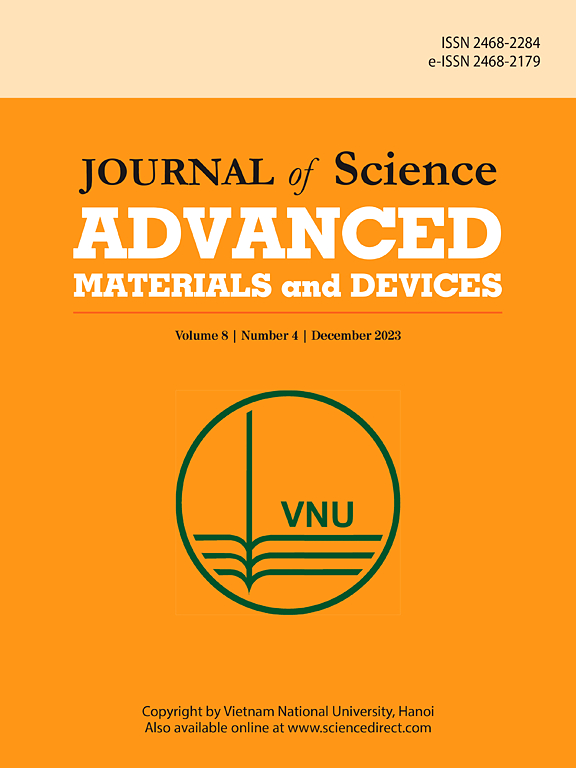高效双成像平台:超声驱动合成铋-氧化铁纳米复合材料
IF 6.8
3区 材料科学
Q1 MATERIALS SCIENCE, MULTIDISCIPLINARY
Journal of Science: Advanced Materials and Devices
Pub Date : 2025-05-14
DOI:10.1016/j.jsamd.2025.100905
引用次数: 0
摘要
与小分子造影剂(CAs)相比,基于纳米颗粒(NP)的成像探针具有更大的有效载荷和更长的血液循环持续时间。增强型双模成像(MRI和CT)将磁共振成像(MRI)的高空间分辨率与计算机断层扫描(CT)的强放射密度相结合,能够实现早期和准确的疾病诊断。合成的Bi-Fe3O4复合NPs具有生物相容性和安全性,对体内临床应用至关重要。使用快速直接的超声波辅助合成过程和绿色化学,特别是天然植物提取物(漆树)作为稳定剂,展示了一种可持续的纳米材料开发方法,可以在保持高功能性能的同时最大限度地减少对环境的影响。采用一系列典型分析方法对Bi-Fe3O4的物理化学性质进行了评价。所制得的纳米粒子具有均匀性、结晶度、半球形和超顺磁性,平均尺寸为17.5 nm,磁化值为92 emu/g。此外,本研究利用流式细胞术、MTT法和普鲁士蓝染色研究了Bi-Fe3O4复合NPs的细胞毒性、细胞内分布和细胞内化。结果表明,复合NPs在暴露条件下具有无毒性、生物相容性和剂量依赖性。利用琼脂糖凝胶为基础的模型,评估了胶体样品的敏感性、弛豫性和衰减特性,以评估其潜在的双峰MRI/CT对比增强。Bi组分表现出极高的x射线衰减性能(399 HU),而Fe3O4组分表现出显著的磁化强度(92 emu/g)和横向弛豫(r2 = 273 mM−1 s−1)缩短能力。本文章由计算机程序翻译,如有差异,请以英文原文为准。

Efficient dual-imaging platform: Ultrasound-driven synthesis of bismuth–iron oxide nanocomposites
Nanoparticle (NP)-based imaging probes exhibit significantly greater payload and longer blood circulation duration compared to small molecule contrast agents (CAs). Enhanced dual-modal imaging (MRI and CT) combines the great spatial resolution of magnetic resonance imaging (MRI) with the strong radiodensity of computed tomography (CT) to enable early and accurate illness diagnosis. Synthesized Bi–Fe3O4 composite NPs are biocompatible and safe, crucial for in vivo clinical applications. The use of a rapid and straightforward, ultrasound-assisted synthesis process and green chemistry, specifically natural plant extract (Sumac) as a stabilizer, demonstrates a sustainable approach to nanomaterial development that minimizes environmental impact while maintaining high functional performance. The physicochemical properties of the Bi–Fe3O4 were assessed using a range of typical analyses. The resulting composite NPs exhibited uniformity, crystallinity, semi-spherical shapes, and superparamagnetic properties, with an average size of 17.5 nm and a magnetization value of 92 emu/g. Furthermore, the research investigated the cytotoxicity, intracellular distribution, and cellular internalization of Bi–Fe3O4 composite NPs using flow cytometry, the MTT assay, and Prussian blue staining. The findings indicated that the composite NPs were non-toxic, biocompatible, and dose-dependent under exposure conditions. The sensitivity, relaxivity, and attenuation characteristics of the colloid sample were evaluated for their potential dual-modal MRI/CT contrast enhancement using agarose gel-based phantoms. The Bi component exhibited an exceptionally high X-ray attenuation property of 399 HU, while the Fe3O4 component showed remarkable magnetization (92 emu/g) and transverse relaxation (r2 = 273 mM−1 s−1) shortening capabilities.
求助全文
通过发布文献求助,成功后即可免费获取论文全文。
去求助
来源期刊

Journal of Science: Advanced Materials and Devices
Materials Science-Electronic, Optical and Magnetic Materials
CiteScore
11.90
自引率
2.50%
发文量
88
审稿时长
47 days
期刊介绍:
In 1985, the Journal of Science was founded as a platform for publishing national and international research papers across various disciplines, including natural sciences, technology, social sciences, and humanities. Over the years, the journal has experienced remarkable growth in terms of quality, size, and scope. Today, it encompasses a diverse range of publications dedicated to academic research.
Considering the rapid expansion of materials science, we are pleased to introduce the Journal of Science: Advanced Materials and Devices. This new addition to our journal series offers researchers an exciting opportunity to publish their work on all aspects of materials science and technology within the esteemed Journal of Science.
With this development, we aim to revolutionize the way research in materials science is expressed and organized, further strengthening our commitment to promoting outstanding research across various scientific and technological fields.
 求助内容:
求助内容: 应助结果提醒方式:
应助结果提醒方式:


